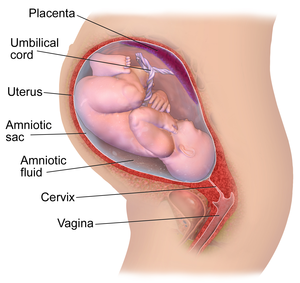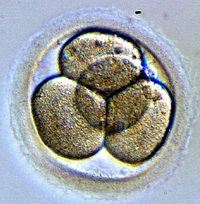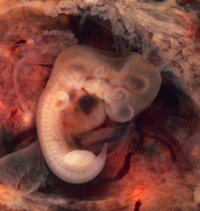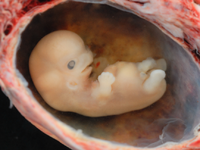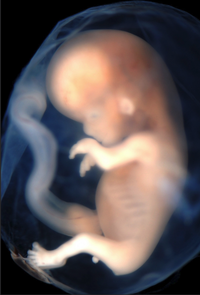Difference between revisions of "Gestation"
| (5 intermediate revisions by 2 users not shown) | |||
| Line 1: | Line 1: | ||
==Key Stage 3== | ==Key Stage 3== | ||
===Meaning=== | ===Meaning=== | ||
| − | [[Gestation]] is the period of time while [[offspring]] | + | [[File:PregnancyDiagram.png|right|300px|thumb|A [[diagram]] showing the final stage of gestation just before the [[offspring]] is born.]] |
| + | [[Gestation]] is the period of time while [[offspring]] are developing in the [[uterus]] of a [[mammal]]. | ||
===About Gestation=== | ===About Gestation=== | ||
| + | : [[Gestation]] may be referred to as '''pregnancy'''. | ||
: [[Gestation]] starts with [[conception]] and ends with [[birth]] of the [[offspring]]. | : [[Gestation]] starts with [[conception]] and ends with [[birth]] of the [[offspring]]. | ||
| − | + | The [[offspring]] goes through several stages of development: | |
| + | : 1. The [[ovum]] is released from the [[ovary]]. | ||
| + | : 2. The [[ovum]] is [[fertilised]] by a [[Sperm Cell|sperm]]. | ||
| + | : 3. The [[embryo]] makes its way to the [[uterus]] where it implants itself into the lining of the [[uterus]]. | ||
| + | : 4. The lining of the [[uterus]] develops into an [[Amnion|amniotic sac]], a [[placenta]] and an [[Umbilical Cord|umbilical]] cord to protect and feed the [[embryo]]. | ||
| + | : 5. The [[Cell (Biology)|cells]] specialise and the [[embryo]] becomes a [[foetus]]. | ||
| + | : 6. The [[foetus]] becomes fully developed and turns itself upside down so it can exit through the [[vagina]] head first. | ||
{| class="wikitable" | {| class="wikitable" | ||
| Line 21: | Line 29: | ||
| style="height:20px; width:200px; text-align:center;" |Once all the [[Cell (Biology)|cells]] have been given their specific jobs it is called a [[foetus]]. A this point the [[offspring]] is preparing to live outside the [[uterus]]. | | style="height:20px; width:200px; text-align:center;" |Once all the [[Cell (Biology)|cells]] have been given their specific jobs it is called a [[foetus]]. A this point the [[offspring]] is preparing to live outside the [[uterus]]. | ||
|} | |} | ||
| + | |||
| + | ==Beyond the Curriculum== | ||
| + | {{#ev:youtube|https://www.youtube.com/watch?v=XEfnq4Q4bfk}} | ||
| + | |||
| + | |||
| + | ===References=== | ||
| + | ====AQA==== | ||
| + | |||
| + | :[https://www.amazon.co.uk/gp/product/0198359373/ref=as_li_tl?ie=UTF8&camp=1634&creative=6738&creativeASIN=0198359373&linkCode=as2&tag=nrjc-21&linkId=952a73bbb09d222ecc4b50d200679849 ''Pregnancy, pages 107, 116, 121, 174-175, GCSE Biology; Third Edition, Oxford University Press, AQA ''] | ||
| + | |||
| + | ====Edexcel==== | ||
| + | |||
| + | :[https://www.amazon.co.uk/gp/product/1292120207/ref=as_li_tl?ie=UTF8&camp=1634&creative=6738&creativeASIN=1292120207&linkCode=as2&tag=nrjc-21&linkId=22455ff53961978667722edaa64c0be5 ''Pregnancy, page 146, GCSE Biology, Pearson, Edexcel ''] | ||
Latest revision as of 14:39, 27 November 2019
Contents
Key Stage 3
Meaning
Gestation is the period of time while offspring are developing in the uterus of a mammal.
About Gestation
- Gestation may be referred to as pregnancy.
- Gestation starts with conception and ends with birth of the offspring.
The offspring goes through several stages of development:
- 1. The ovum is released from the ovary.
- 2. The ovum is fertilised by a sperm.
- 3. The embryo makes its way to the uterus where it implants itself into the lining of the uterus.
- 4. The lining of the uterus develops into an amniotic sac, a placenta and an umbilical cord to protect and feed the embryo.
- 5. The cells specialise and the embryo becomes a foetus.
- 6. The foetus becomes fully developed and turns itself upside down so it can exit through the vagina head first.
| After fertilisation the ovum divides into two cells, then four cells. | This embryo has many cells that have not yet been given a specific job. |
| The cells in this embryo are being assigned specific jobs as it starts to look more like a human. | Once all the cells have been given their specific jobs it is called a foetus. A this point the offspring is preparing to live outside the uterus. |
Beyond the Curriculum
